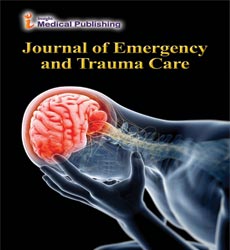Spine Trauma Retrospective and Design Application
Safa Fischl *
Department of Emergency Medicine, Qazvin University of Medical Sciences, Qazvin, Iran
- *Corresponding Author:
- Safa Fischl
Department of Emergency Medicine, Qazvin University of Medical Sciences, Qazvin, Iran
E-mail: safa.fischl@qu.ir
Received Date: September 03, 2021; Accepted Date: September 17, 2021; Published Date: September 24, 2020
Citation: Fischl S (2021) Spine Trauma Retrospective and Design Application. J Emerg Trauma Care Vol.6 No.1:24.
Description
Thromboembolic sickness after backbone surgical operation drastically will increase health facility period of stay, health facility costs, and mortality quotes. Even though the bulk of sufferers with acute spinal twine accidents are young, the effect of thromboembolic sickness at the morbidity and mortality of those sufferers is properly documented, with quotes as excessive as 67%-100% amongst untreated sufferers. Within this affected person profile, pulmonary embolism is the 3rd. maximum not unusual place purpose of death. The hazard of venous thromboembolism is finest at some point of the primary 12 weeks after the injury, while flaccidity, paralysis, or immobilization of the extremities permit the “stasis” aspect of Virchow’s triad to predominate. Additionally, spinal twine accidents may additionally result in autonomic dysregulation, in the end growing coagulability thru modifications withinside the hemostatic and fibrinolytic cascades.
Once the present literature turned into reviewed and consolidated, the protocol turned into created. The very last product turned into the end result of more than one revisions primarily based totally at the efforts of the authors and the enter of the multidisciplinary committee. This assignment turned into undertaken as a first-rate development initiative at Baylor University Medical Centre (BUMC), and as such turned into now no longer officially supervised via way of means of the Institutional Review Board. We did now no longer intend to supersede sound medical decision-making however as an alternative aimed to layout and put into effect a protocol that could result in safe, consistent, and well timed management of thromboembolic prophylaxis for the ones eligible backbone trauma patients.
To simulate the capacity effect that our mounted protocol might also additionally have had on preceding thromboembolic events, we recognized beyond instances of vertebral column fractures and/or spinal wire accidents inside the institutional trauma database, the “Baylor Trauma Registry,” primarily based totally on ICD10 codes. There had been 3987 overall trauma arrivals on the BUMC ED in 2017, the yr. decided on for review. We then screened for ICD-10 classes S12, S14, S22, S24, S32, and/or S34, which constitute diagnoses of vertebral column fractures and/or spinal wire accidents. There had been 929 sufferers labelled into those classes. After doing away with trauma sufferers with remoted pelvic fractures, there had been 466 sufferers recognized that met inclusion criteria. Of the ones 466 sufferers with vertebral column fractures and/or spinal wire accidents, four sufferers had been recognized with DVTs even as admitted. The information in their health facility path had been cautiously reviewed, and retrospective software of the protocol turned into implemented to theorize what effect, if any, our protocol might also additionally have had on DVT prophylactic strategies in every instance.
Open Access Journals
- Aquaculture & Veterinary Science
- Chemistry & Chemical Sciences
- Clinical Sciences
- Engineering
- General Science
- Genetics & Molecular Biology
- Health Care & Nursing
- Immunology & Microbiology
- Materials Science
- Mathematics & Physics
- Medical Sciences
- Neurology & Psychiatry
- Oncology & Cancer Science
- Pharmaceutical Sciences
